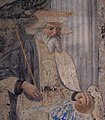Besides, the pope or Avitus were not the only Catholics in Sigismund’s life. There were many in the Burgundian royalty who were also Catholic, most importantly Sigismund’s mother, Caratena. Of course, Sigismund’s cousin, Clotilda, was also Catholic, as was her mother and sister. Shanzer and Wood also add that “[i]n fact it is difficult to find named Burgundian women who were Arian.” However, Avitus did have a close relationship with Sigismund. On more than one occasion, he wrote to Sigismund to express his disappointment at not having seen him over Easter or when Sigismund had been traveling through Vienne. On other occasions he wrote of his concern for the safety of Sigismund while on a military campaign.
Sigismund had probably been elevated to the position of rex, or sub-king, by his father, some time around his conversion. Thus, he was most likely quite an experienced politician by the time his father died and he ascended to the throne. While his father was still alive, he had recognized the precarious position of his kingdom geographically between the Franks and Goths and he sought the aid of the emperor in Byzantium. He wrote to Byzantium to re-assert the status of the Burgundian kingdom as technically a legal territory of the empire, or federated regnum, and to maintain good relations between Constantinople and the Burgundian kingdom (Musset probably derived his assessment of Sigismund from these letters).
In his letters, Sigismund reminded the emperor of the role that Burgundy played as a vital part of the empire in Gaul, and, more importantly, lobbied for an imperial position commensurate with one who led such a vital part of the empire. He was rewarded with the title of patricius as a result of this correspondence. Upon his assumption of the Burgundian throne, he received the more important title of magister militum. These events were noticed by Theodoric, whose own relations with Byzantium had crumbled. He attempted to cut off diplomatic traffic between the two, most of which were letters written by Avitus of Vienne, by not allowing Sigismund's messengers to travel through Italy to Constantinople.
Sigismund had a few important accomplishments. He had built a monastery at Saint-Maurice
 d’Agaune in A.D. 515 and the monks supported him. He added to the Lex Gundobad. Lyons, and possibly Vienne, had schools of rhetoric and archeologists have traced Latin inscriptions to this period. It was he who, in A.D. 517, had called for the royal synod at Epaon and who also held several provincial synods during his reign.
d’Agaune in A.D. 515 and the monks supported him. He added to the Lex Gundobad. Lyons, and possibly Vienne, had schools of rhetoric and archeologists have traced Latin inscriptions to this period. It was he who, in A.D. 517, had called for the royal synod at Epaon and who also held several provincial synods during his reign.Unfortunately, the Catholic bishops were disappointed by Sigismund’s actions in a case involving his royal treasurer Stephanus in an incestuous relationship with a woman named Palladia. The murderous palace scandal resulted in a “no-confidence” vote by the Catholic bishops and contributed greatly to erosion of ecclesiastical support for Sigismund. Though a resolution was made, Sigismund would never recapture the same standing among the ecclesiastics that he had once held.
Additionally, the revenue stream, increasingly reliant upon the a shrinking pool of Gallo-Roman landholders who saw no such taxation requirements put upon their exempted Burgundian neighbors, may have been drying up. Musset:
Everywhere, in fact, the fundamental resources of the state continued to be provided by the Roman taxation system, the burden of which rested on the Roman inhabitants, through the medium of a government land survey whose registers continued to be kept more or less up to date; the general exemption from taxes which the barbarian estates enjoyed must have diminished the yield as well as increased the burden.Thus, while the money supply shrank, the resentment among those contributing to it grew.
Sigismund also had problems within his immediate family. His first wife, the daughter of Theoderic of Italy, had died giving birth to his eldest son Sigeric. According to Gregory of Tours account, Sigismund’s second wife disliked Sigeric and conspired to make Sigismund suspicious of Sigeric’s motives towards his father. She convinced him that Sigeric was conspiring with his grandfather Theoderic to seize Burgundy from Sigismund. Her conniving was successful and Sigismund made plans to have Sigeric murdered.
As the story goes, Sigismund got his son drunk until he passed out and then had two retainers strangle him. He immediately regretted his act as, according to Gregory of Tours, he “threw himself on the dead body and wept most bitterly.” Burgundian outrage at this vicious murder combined with the recent loss of ecclesiastical support proved to be Sigismund’s undoing. He might have survived, despite this internal unrest, had not external factors also contributed to his downfall.
UP NEXT: Godomar, Last King of the Burgundians
SOURCES
Wood, “Kings, Kingdoms and Consent"
Avitus of Vienne.
Musset, Germanic Invasions.
Avitus, Epp. 93 and 94 in Opera, ed. Piper, 1883 in Bury, Roman Empire.
Wolfram, Germanic Peoples.
Wood, The Merovingian Kingdoms.
Wood, “Incest, law and the Bible in sixth-century Gaul."
Gregory of Tours, The History of the Franks.
Marius of Avenches in Murray, Merovingian Gaul.
Kurth, Saint Clotilda.